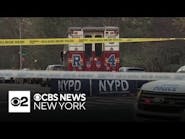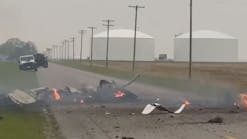Your engine company has been dispatched to a serious motor vehicle accident. Once on scene, fire personnel begin the extrication of victims from the vehicle. On-scene EMS personnel begin treating the victims and they quickly determine that one patient needs helicopter transport to the nearest Level One trauma center. The on-scene commander requests a medevac helicopter. Within minutes, a multimillion-dollar aircraft with whirling main rotor blades and nearly invisible spinning tail rotor blades will be landing nearby to transport the patient to the hospital.
Photo by Bill Green Maryland State Police Trooper 3 makes its final approach to an accident scene in Carroll County. The landing zone has been established on the roadway, in front of the accident.
In this article, I provide general information about setting up a landing zone and precautions to take around a helicopter. My goal is to prevent a firefighter or EMS provider from becoming an additional patient at the accident scene. Also, in the unlikely event of a helicopter landing accident, this information may assist fire personnel in the rescue of the helicopter flight crew.
Helicopters are uniquely capable aircraft. The ability to hover and takeoff and landing vertically allows the helicopter to perform a variety of missions - airborne firefighting, law enforcement, offshore oil rig support, logging, military troop transport and resupply, crop spraying, and corporate transport just to name a few. The greatest mission that the helicopter performs, however, is the saving of human lives.
Since World War II, when the first practical helicopters were produced, hundreds of thousands of lives have been saved by the helicopter. Today, throughout the country, more and more local fire companies are being dispatched to secure landing zones for medevac helicopters. Safety for the firefighters and the aircraft flight crew is the highest priority. For all the lives the helicopter has saved, the aircraft is a dangerous machine.
Safe Landing Zone
While the helicopter is enroute, a landing zone must be selected and prepared. The helicopter flight crew that serves your area should have instructed your personnel in what they need for a safe landing zone; if not, contact them.
Here are 11 general guidelines for setting up the landing zone:
- The ideal landing zone is a level, 100-by-100-foot or larger area of grass or hard surface. Most civilian medevac helicopters in use today have a main rotor diameter of 35-50 feet and a fuselage length with main rotor blades turning of 40-50 feet. U.S. military helicopters are much larger.
- The landing zone should be free of debris such as gravel, litter or any materials that may become deadly airborne projectiles due to the helicopter's main rotor wash. A medium-size, two-patient helicopter will produce a wind on landing and takeoff that has a velocity of 60-80 mph. Something to consider: A tropical storm is upgraded to a hurricane when its winds exceed 73 mph.
- The landing zone should be as close to the accident scene as possible without jeopardizing the safety of the personnel on the ground. A landing zone close to the scene saves time but safety must never be compromised. Some communities have designated landing zones such as school athletic fields. The landing zone should allow the helicopter to approach and depart along a path that is free from obstructions such as trees, power lines and light poles.
- Normally, a helicopter will land and take off into the wind. This is the safest, least power-demanding direction for the helicopter to land and take off. To assist the pilot in determining wind direction and speed at the landing zone, a bright streamer or flag can be securely attached to a whip antenna on the apparatus. The use of a flare or smoke device is hazardous and not recommended.
- Secure the perimeter of the landing zone so that onlookers or vehicles will not enter the area. A helicopter draws a crowd. With the helicopter on the ground and running, the pilot in the right cockpit seat is unable to see behind the aircraft. Therefore, after the helicopter has landed, station a firefighter at least 100 feet behind the aircraft to prevent someone from approaching the helicopter from behind and possibly walking into the tail rotor.
- Day or night, mark the corners of the landing zone with steady RED auxiliary lights. Flashing red or whites lights are distracting to the pilot, especially at night. Do NOT use traffic cones, flares or flags as the main rotor wash will blow these objects around. A lit flare blowing around can easily start a fire.
- Notify the pilot of ALL obstructions in the vicinity of the landing zone. When in doubt; point it out. At night, AFTER the helicopter has landed, use the fire apparatus' moveable searchlights to illuminate obstacles such as power lines and trees. NEVER shine lights directly at the helicopter as you will temporarily "blind" the pilot.
- Notify the pilot of any significant slope, tall grass or tree stumps. With most helicopters, there is very little ground clearance between the bottom of the fuselage and the ground. A tree stump can easily pierce the fuselage skin.
- After the flight crew has located the landing zone from the air, ALL vehicle white lights should be turned OFF during the landing, patient loading and takeoff except those lights used to illuminate obstacles. The landing and takeoff phases of helicopter flight are the most demanding and dangerous. The multitude of flashing red and white lights on today's fire and EMS apparatus are very distracting to the pilot.
- All fire and EMS apparatus should be clear of the landing zone with their passenger doors, exterior compartment doors, trunks, hoods and windows closed. The main rotor wash will easily rip off an apparatus' door or break a door hinge. Equipment stored on the exterior of fire apparatus such as canvas hose bed covers must be tightly secured.
There is no need to stretch a line. Helicopters are now equipped with self-sealing fuel tanks along with self-sealing breakaway fuel and oil lines so a post-crash fire is remote. The helicopter main rotor blades turn at 300-360 rpm and the tail rotor blades turn at 3,000-3,600 rpm. In the event of a landing accident, personnel should take cover because there is a tremendous amount of flying debris. Broken main rotor blades can easily travel over a mile before coming to a stop. - The pilot is the final authority in accepting an area for landing. If the pilot is uncomfortable with the landing zone, an alternate area will be needed. This is by no means a reflection on the performance of fire personnel in choosing a landing zone.
Photo by Bill Green Maryland State Police Medic Eric Smothers assesses a patient who was electrocuted and fell from an aerial platform. Carroll County volunteers brought the injured man from the scene in a wooded area to a clear and safe landing zone about one mile away. He was flown to Baltimore.
Loading The Patient
The helicopter has safely landed. Now comes the patient loading. Some medevac helicopters will only load patients "cold," when the helicopter is completely shut down. Others such as the Maryland State Police helicopters, conduct "hot" loading of the patient. The helicopter is still running. The safest patient loading is obviously "cold" loading. However, "hot" loading is safe if the following 9 general guidelines are followed.
- Be sure to secure all loose personal objects. ALL hats and helmets should be removed. Long hair should be controlled. Stethoscopes should be placed in pockets. Fire personnel should properly wear boots, bunker pants, turnout coats and gloves; NO helmets.
- Always wear protective eyewear. The main rotor wash will easily pick up small stones, glass and other debris which can cause serious eye damage. Helicopters are very loud - 90-120 decibels - so always wear hearing protection.
- Keep all fire and EMS apparatus and personnel at least 100 feet from the landing zone. Except for the firefighter securing the rear of the helicopter, all personnel should be in full view of the pilot.
- Do NOT enter the landing zone. The flight crew will come to you.
- Unless there is a landing mishap, NEVER approach the helicopter unless accompanied by a member of the flight crew.
- ALWAYS approach the helicopter from the front. All personnel must receive a "thumbs up" from the pilot prior to walking under the turning main rotor blades.
- NEVER approach the helicopter from the rear or from up slope. As stated before, the pilot cannot see the rear of the helicopter. The tail rotor is very dangerous as it turns so fast it's nearly invisible.
- Do NOT run near the helicopter and be especially careful on wet or slippery ground. The main rotor wash may cause personnel to slip and fall.
- NEVER raise hands, intravenous solutions or any other objects over shoulder height. The helicopter main rotor blades can dip as low as four feet. In 1996, a U.S. Army flight surgeon was killed instantly when he was struck in the head by a turning main rotor blade on a UH-60 Blackhawk helicopter. The pilot did not know the flight surgeon was deplaning and a main rotor blade unexpectedly dipped down.
Photo by Bill Green Maryland State Police Trooper 3 makes a landing onto the road surface at an auto accident on U.S. 15 near Emmitsburg, MD. Emmitsburg Valiant Hose Company members are shown in foreground. Engine 63 is at right.
Whose Job Is It?
There is an ongoing debate between the fire and law enforcement communities over who should set up a medevac helicopter landing zone. The Federal Aviation Administration (FAA) has no rules or regulations governing the landing of medevac helicopters at accident or rescue locations. (On every U.S. military bases, however, a manned crash rescue vehicle is always present whenever a military medevac aircraft is loading or unloading patients.)
For the following reasons, I recommend that local authorities adopt the policy of always dispatching an engine company to set up the landing zone for medevac helicopter.
First, there is 100-300 gallons of Jet A fuel, flammable oil, hydraulic fluid, medical oxygen and a NiCad battery on board the typical medevac helicopter. As stated previously, crashworthy fuel systems have greatly lessened the chance of a post-crash fire but the possibility still exists for a fire. An engine company at the landing zone has the personnel, equipment and knowledge to quickly handle a helicopter fire. The police officer with a fire extinguisher does not.
Second, helicopters are made of lightweight aluminum, titanium and composites such a fiberglass and Kevlar. During a hard landing or crash, there is the strong likelihood that the helicopter will roll over, resulting in the fuselage deforming. Even if the helicopter comes to rest upright, the impact forces still will probably deform the fuselage. This will result in the aircraft doors becoming jammed. Extrication of the flight crew will be required. An engine company with extraction tools and trained personnel will be able to quickly and safely extract the flight crew. A police officer would be virtually helpless in such a situation. Police officers are well trained for traffic and crowd control and motor vehicle accident investigation. Police officers, however, are not trained to fight an aircraft fire or extract personnel from aircraft wreckage.
In the event of a helicopter landing accident, an engine company, on scene, properly trained and equipped, gives the flight crew the best possible chance of survival.
David C. Delisio is a civilian helicopter pilot with the Maryland State Police assigned to Trooper 3 in Frederick. Previously, he flew search-and-rescue helicopters in the U.S. Air Force and U.S. Coast Guard. He has 18 years and over 5,300 flight hours of experience. For a condensed version of these guidelines, contact the author at 301-663-5742.









